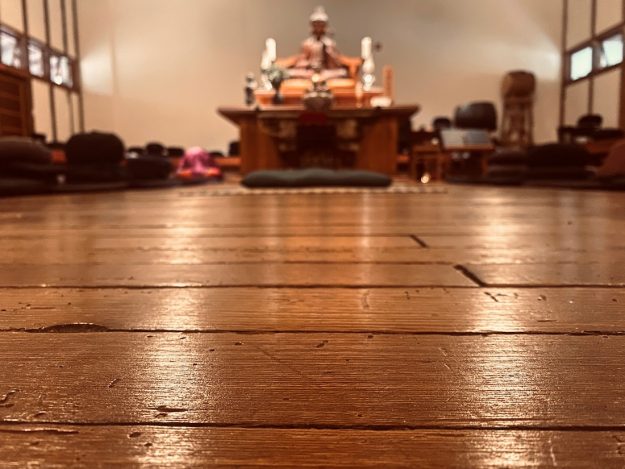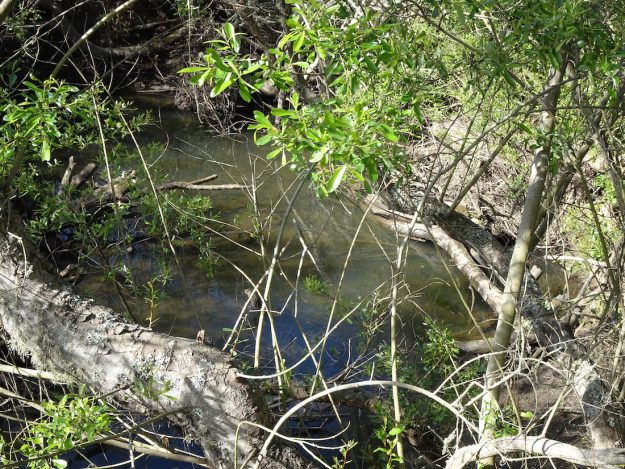Water does not flow up; it always flows down.
–Shunryu Suzuki Roshi
The wooden floor of the Green Gulch zendo gleams with quiet natural light reflected from its polished surface. It was originally a dairy barn, built directly over Green Gulch Creek so they could muck the manure straight into the creek and wash it into Redwood Creek and on to the ocean at Muir Beach—at least during the season when the little creek was flowing. In the half-century since the San Francisco Zen Center acquired Green Gulch Farm and repurposed the barn as a temple and hall for sitting meditation practice (zazen), the oil and sweat from thousands of bare feet have seeped into the old redwood floor and given it a beautiful sheen. A statue of Manjushri, the bodhisattva of wisdom, stands at one end of the hall.

I visited the farm and Zen Center on a sunny mid-April morning in 2022. Sara Tashker, the farm manager and a longtime resident, led me on a tour and oriented me to the place and its history. After looking around the zendo, we wandered down the road along the creek and beside the farm fields. We peeked into a greenhouse to check on flats of tender baby lettuces waiting to be outplanted and then walked down to look at the ecological restoration work that has been happening here for more than fifteen years. “What inspired that?” I asked Sara. “How did that get started?”
The winter of 2004–2005 was a wet one, Sara told me. That winter, when the rains had recharged the watershed and broken through the sandbar at Muir Beach, someone had spotted a big red fish thrashing around in Green Gulch Creek—a male coho salmon in full spawning colors. Everyone was amazed. At least one pair must have spawned successfully that winter; in April, the Golden Gate National Recreation Area’s aquatic ecologist found baby coho in the creek.
The coho salmon (scientific name Oncorhynchus kisutch) found at Green Gulch belong to a genetically distinct and evolutionarily significant subgroup of the species. Coho in this area of the Central California Coast were first listed as “threatened” under the Endangered Species Act in 1996, and uplisted to “endangered” in 2005. A final recovery plan was published in 2012 and is still being implemented.
The discovery of the salmon reoriented the Green Gulch community. Over the next few years, they resolved to “free the creek” and make it the “center” of Green Gulch. The creek had shaped the valley and deposited the soil they were farming; and now, endangered salmon were trying to come back. “Our life as a community didn’t reflect the centrality of the creek to this place,” Sara said. “That led us to a watershed view.” The vision statement that emerged from the process said:
As the vow to benefit all beings grows more rooted in this valley, the Green Gulch Farm community enters into a more intimate relationship with this beautiful and bountiful place. The profound listening that comes out of this relationship helps us to hear more clearly the voice of the land and of the watershed itself and to realize our deep interconnection with the natural world. It is with humility and an understanding of our role and responsibility to act interdependently with the wider community—the soil, water, plants, animals and people—that we propose a long-term vision for Green Gulch Farm.
I tried to imagine that view: a view of everything connected, upstream and downstream, from clouds to ocean, from Mount Tamalpais above to Muir Beach below and out into the ocean beyond, where the salmon wait for the rains so they can swim upstream and where people, embedded in the ecosystem, wait to greet them.
***
Coho begin their life cycle in freshwater rivers and streams and then spend three years feeding and growing, much of that time in the ocean, before returning to spawn in the streams where they hatched. In spawning, females build nest-like depressions called “redds” in the gravel of a stream bottom, and as they release eggs into them, male salmon swish over, releasing sperm to fertilize the eggs. Salmon are mostly faithful in returning to the same stream where they hatched, apparently navigating “home” using chemical cues that give their natal water a unique flavor. To a coho, Green Gulch Creek must have its own special taste.
In a given year, the returning salmon are the offspring of parents that spawned three years earlier—and with luck will be the parents of the generation that will return to spawn in another three years. This three-year anadromous life history apparently evolved as an evolutionary strategy to allow salmon to survive in a dynamic environment—the North Pacific Ocean—and it has been successful for the many millions of years they have existed there. Still, there are many climatic “what ifs” that affect the salmon. When the sandbar at Muir Beach is breached after winter rains have swollen the creek, some returning spawners may sprint for the smaller tributaries upstream and build redds up in Kent Creek or Fern Creek. Other fish may loiter lower in the watershed and spawn downstream, maybe even in Green Gulch Creek, which enters Redwood Creek near its mouth at Muir Beach. Then the odds kick in. If the rains are not strong, the baby fish in the upper watershed may get stranded as their pools dry and become disconnected from the flow. But if the rains are serious, high flows on the mainstream of the creek may wash the eggs and baby fish from redds there, and babies in the upper watershed might have a better chance of survival. Given all these environmental variables, the more stream-miles with suitable flows and gravels that the fish have access to, the better.
***
The Green Gulch watershed is a microcosm that illustrates how people shape landscapes through their choices and actions, which are in turn influenced and guided by their perspectives and worldviews. Understanding the human history of a place is an important step in restoring it ecologically and reinhabiting it psychologically. Miwok hunter-gatherers were the first human inhabitants here, and coastal grasslands would have been much more extensive then because of their liberal use of fire in their ecological management. The Spanish mission system severely reduced the native population and all but destroyed its ecologically adapted culture. In 1836, after the mission system collapsed, the area became a Mexican land grant, used mainly as open cattle range. Ranching and some small-scale dairy farming continued until the turn of the 20th century, and hunting, hiking, and other recreational uses increased. Thankfully, the redwoods along Redwood Creek just two miles upstream from Green Gulch were protected within Muir Woods National Monument, established in 1908.
After World War II, Green Gulch was purchased by George Wheelwright, a wealthy physicist and co-inventor of the Polaroid camera, who sought to transform the land into a model modern cattle operation. He imported prize Hereford cattle from England, cleared the slopes of native vegetation, planted pasture grasses from New Zealand, channelized the creek between berms like an irrigation ditch, filled in the wetlands along the lower creek, and built a levee to prevent seawater from flowing up from the Muir Beach lagoon into the lower section of his property. Wheelwright clearly had a hard, technology-in-control vision of the human-nature relationship at Green Gulch, but that is not really surprising—his worldview was created by and reflected the mainstream worldview of his time. But in spite of his engineering mentality, following the death of his wife in the late 1960s, Wheelwright deeded Green Gulch to the San Francisco Zen Center for a fraction of its market value in 1972—to “a bunch of beatnik hippie Zennies,” as Sara put it—so it would be cared for and protected.
Green Gulch then became a laboratory for experiments with a more ecological and spiritual human-land relationship. Horticulturist Alan Chadwick brought and taught “biodynamic” farming techniques. Architect Sim Van der Ryn, a pioneer in ecological design, planned several buildings (and a composting toilet) on the property. Through relationships with several Native American collaborators, indigenous perspectives and traditional ecological knowledge influenced the work at Green Gulch; a patch of coyote willow is tended and pruned to produce young, straight willow shoots for traditional basketry, for example. Just up Redwood Creek, perched on the slope near Muir Woods, was Druid Heights, another outpost of experimentation with aspects of human nature. The Way of Zen author Alan Watts lived there for a time, as did poet and environmentalist Gary Snyder, and they were frequent visitors.
***

The actions and worldviews of individuals—those mentioned above and many others—are recorded in the landscape at Green Gulch. As we walked the property, Sara showed me the legacy of the Green Gulch community’s “free the creek” initiative from 2008, which received support from the National Park Service and other partners. The levee that cut off the free flow of water from the Redwood Creek estuary was removed, a natural meander of the creek restored, and native riparian vegetation is now thriving.
A parade of “atmospheric river” storms has been drenching California since December 2022, and the storms continue to produce historic heavy rains. The water broke through the sandbar at Muir Beach, opening the way for salmon, recharging the Redwood Creek watershed, and scouring the creek bed gravels. Green Gulch Creek is flowing full.
In a beautiful dharma talk presented to the San Francisco Zen Center on Earth Day 2021, Sara Tashker described what George Wheelwright did as “the engineering of Green Gulch Creek.” She asked what sort of worldview would lead to a “straightened, gravel-starved creek, with check-dams blocking fish passage, and drastically reduced riparian habitats for myriad species?” A human-centered one, she explained, which assumes that:
Humans know best; humans can control water, plants, animals, life; the purpose of this land is to support me, my life, my livelihood, human activity; human activity is more important than the activity of other forms of life; the success of my human activity can be separated from the success of other forms of life in this ecosystem; I can control the consequences of my actions; the abundance of the natural world will always be available to me, no matter what I do; and finally, what I see and think is true and complete.
I don’t know of a more clear or comprehensive enumeration of the elements of the anthropocentric Western worldview that is the root cause of our ecological crisis than this. This human-supremacist worldview now dominates, and is used to justify, the current unsustainable global economic and geopolitical system.
But there’s a problem. The human-centered myopia that motivated Wheelwright’s attempt to control Green Gulch Creek doesn’t conform to ecological reality. It is like trying to make water flow uphill. The reality is that we humans are only one of millions of species in the biosphere, upon which we are completely dependent, and we are a relative newcomer at that. In Sara’s words, we are “completely made up of and in turn are part of making the relentlessly dynamic, complex, interdependent activity of life.” Therefore, she said, the aspiration of the Green Gulch community is to “support the unobstructed flow of the creek, and of reality.”
And with that will come the coho, nosing up under the zendo in another wet year. Another big red fish, a bodhisattva-like messenger bringing instant insight into the reality of interconnectedness, interdependence, interbeing. Like the twirling of a flower in Shakyamuni’s famous flower sermon, a sudden awakening; a salmon sermon.
Water always flows down, but salmon swim up!